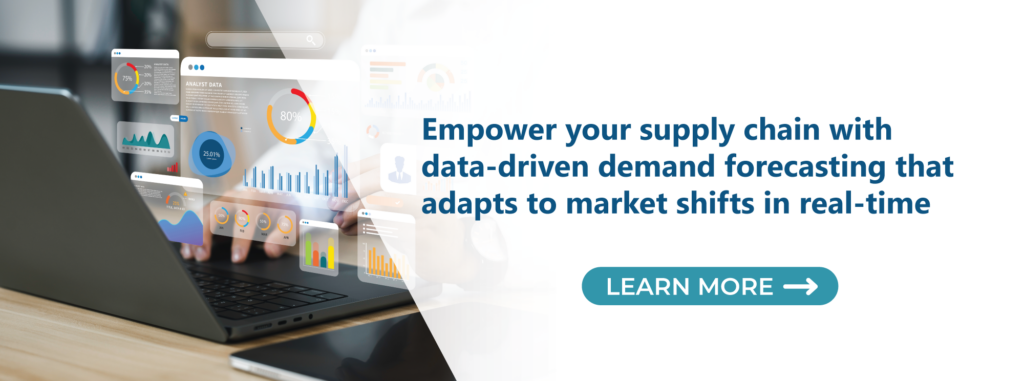In today’s ever-evolving marketplace, effective demand planning has become a critical component of supply chain success for businesses of all sizes. An accurate demand forecast not only helps align supply with market needs but also enables organizations to respond quickly to fluctuations in demand, minimizing the risk of stockouts and overstock situations. As competition intensifies and consumer expectations rise, mastering the art of demand planning is essential for driving operational efficiency, improving profitability and ensuring long-term success in the supply chain landscape.
Every business is different, so there’s not a singular one-size-fits-all approach that you can follow to perfect your demand planning process. That said, there are a number of areas you can focus on to make it more effective.
- It’s all about data. Good data. Data collection — historical transaction data, point-of-sale data, customer feedback, even key indicators like weather — can make or break your demand planning process. And, today, there’s more data available than ever. No business is going to have perfect, complete data but there is a threshold for sufficient quality and as the data set grows, quality will drop below that threshold if it is not carefully maintained. Remember that, when it comes to data, it’s “garbage in, garbage out.” Cleansing data — even if it’s only to remove outliers or to separate your base volume from sales lifts due to seasonal demand or promotions — will make your forecasts more accurate and get you closer to gold-standard demand planning.
- Put technology to work. If you haven’t already done so, it’s time to replace those disparate Excel spreadsheets with a centralized system that includes integrated business planning (IBP) and sales and operations planning (S&OP), both of which should be managed on a monthly basis. Demand planning success depends on long-term strategic planning and evaluation, a process that suffers when too much focus is placed on solving problems on a day-to-day basis. Modern demand planning solutions have the capability to manage and analyze your data in a way that helps you keep your eye on the big picture.
- Get everyone on board. You can’t do demand planning in a silo and expect it to positively impact the whole organization. Forecasting itself will only go so far; demand planners and other stakeholders must be able to build off the same set of numbers to get their own projections done. At minimum, be sure to involve:
-
- Sales reps: They’re on the phones with customers and meeting with them regularly, so they have the clearest picture of what customers will be ordering.
- Demand planners: This team needs the data and needs to know how to work with it. They’re the synthesizers.
- Demand managers: These “overseers” are crucial because they review the plans and see to it that demand planners are building the experience and skills to get the job done.
- Make planning a monthly exercise. Today’s business environment and supply chains must move quickly to adapt to ever-changing customer preferences and demands. Monthly plans have become the industry standard. There are a few instances where you go off other calendars driven by the nature of the product, like short shelf lives, specific growing seasons or other constraints, but a monthly cadence aligns nicely with fiscal policies and procedures.
- Put KPIs like weighted MAPE in place (and use them). Key performance indicators like mean absolute percentage error (MAPE) help companies understand the accuracy of their demand forecasts, with a lower MAPE being a sign of a more accurate forecast (and vice versa). Weighted MAPE lets you emphasize an aspect of your choice, usually sales volume. For example, let’s say you have a list of five products and one of them makes up the majority of your portfolio in terms of sales. Looking at the forecast accuracy for all the products holistically, you won’t see that one of them is the most important. Weighted MAPE lets you see your demand planning accuracy for the product that’s doing the highest volume, the one that matters most to your overall success.
- Factor individual biases into the equation. Sales reps are optimistic by nature. They live and die by commission and tend to focus on the positive. Demand managers, on the other hand, are more conservative and often focus on more negative forecasts, adopting more cautious approaches and underestimating demand to avoid excess inventory. Over time, you’ll see these trends of over- and under-forecasting. For best demand planning results, you’ll want to take these biases into account and work to balance them out. For example, you could create an automated dampening factor that offsets the bias in both directions and sets the forecast at a happy medium that better reflects the reality of the situation.
The Right Tools for the Job
The modern supply chain is a complex animal that can’t be tamed using age-old processes like spreadsheets, disparate systems and sticky notes. In this dynamic and unpredictable market, accurate demand planning is table stakes for companies of all sizes and across all industry sectors so they can sense changing trends and respond quickly to fluctuating demand. That means being able to make sense of endless streams of data that are coming into the business and using it to make a solid plan and predict possible changes before they occur. At Arkieva, we offer a full suite of demand planning solutions that help create a centralized demand plan to plan proactively, trace changes and harmonize collaboration across the entire organization.
This blog is the first in a series examining best practices to refine your processes and develop a more reliable, more robust supply chain.













